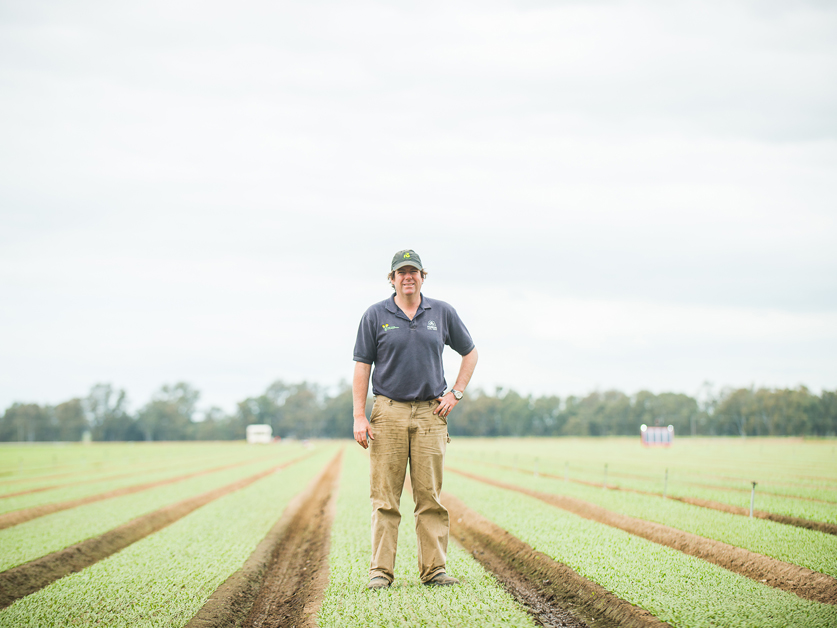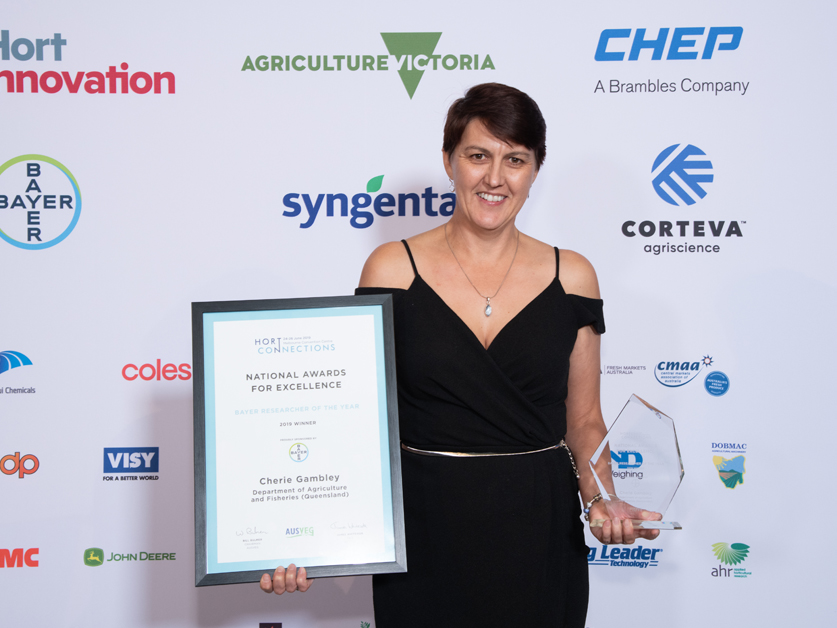
Josh Langmaid: Young grower on the rise
24 September 2019
Gaining a wealth of knowledge around healthy soils
24 September 2019Since graduating from the University of Queensland with a Bachelor of Science (majoring in microbiology) in 1994, Dr Cherie Gambley has conducted research across many Australian horticultural commodities, including vegetables. Cherie’s contribution to the industry was celebrated in June this year when she was named 2019 Bayer Researcher of the Year. Michelle De’Lisle speaks to Cherie about her career and achievements.
A plant pathologist is someone who studies plant diseases, including what causes the disease; where the disease came from; how it spreads in the environment or crops; and how to manage the disease. Plant pathologists play a vital role in the vegetable industry and the wider horticulture sector, protecting these billion-dollar industries from pests and diseases and assisting growers in managing what has already reached our shores.
Dr Cherie Gambley is a Principal Plant Pathologist with the Department of Agriculture and Fisheries, Queensland. In June, Cherie was recognised for her contribution to horticultural research when she received the Bayer Researcher of the Year Award at the Hort Connections 2019 National Awards for Excellence Gala Dinner.
For over 20 years, Cherie has worked across a variety of crops, including sugar cane, banana, pineapple, capsicum and chilli. In that time, she has progressed from research assistant to Principal Plant Pathologist, as well as becoming group leader within the Horticulture and Forestry Science group of the Department. Cherie has completed several projects for the vegetable industry, and is currently involved in ongoing projects such as Area Wide Management of Vegetable Diseases: viruses and bacteria (VG16086) and Characterisation of a Carlavirus of French Bean (VG15073). Both projects are strategic levy investments under the Hort Innovation Vegetable Fund.

Disease focus
There are many different types of organisms that can cause plant diseases, including bacteria, viruses, fungi, oomycetes and nematodes. According to Cherie, plant pathologists tend to specialise into one or two areas because of the wide diversity of these organisms.
“My focus is on diseases caused by bacteria and viruses, and my role is to lead research in plant pathology of horticulture crops for the Department. Primarily, the research is centred on crops of economic importance to Queensland with a second broader national focus, particularly in relation to quarantine and biosecurity,” she says.
“My research revolves around developing an understanding on how specific diseases establish and spread. The ultimate aim is always to find solutions to the economic impacts these diseases can cause through cost-effective management strategies for growers.
“I also have a strong interest in better preparing the industry for diseases we don’t currently have in Australia. This is through continued monitoring of situations overseas, as well as evaluating the likelihood that these diseases will come into Australia and developing strategies to respond to them if they do.”
Cherie interacts with vegetable growers in her role, as well as private businesses within the industry, such as consultants, private research providers, seed companies and chemical companies. She is currently based in the Granite belt growing district and has been providing local diagnostics for horticulture moving to the district in 2014.
Cherie has worked as a researcher in the horticulture industry for over 20 years and has always had strong ties to agriculture.
“I also grew up within the agriculture industry on a beef cattle farm in northern New South Wales, and have always had an affinity with primary production,” she says.
“in my current national project, the project heads for the other agencies – bar one – are all female,"
Research scope
In accordance with her current research, Cherie believes that further work on the feasibility of area wide management of plant diseases would be beneficial for Australia’s vegetable industry.
“We can develop the technical management tools; however, getting adoption of these on the required scale is not straightforward. Understanding the socio-economic drivers behind this is very important as they are likely to be different in each growing district. This type of research and understanding would also help to manage other organisms, such as insect pests and weeds,” she says.
“I also believe we should start investing in research of new DNA-based technologies to solve some of our cryptic disease problems. There are new gene editing techniques in particular that could provide very effective and robust improvements to disease management.”
Through her attendance of international research workshops, conferences and study tours, Cherie has established a strong network with key researchers, particularly in the United States and Europe.
“These networks are particularly valuable as their production systems for vegetables are very similar to ours, as are the disease problems they work with,” she says.
“Collaborating with peers from other countries is very beneficial for Australian researchers. It allows us to get better value for our research dollars as we can use the information generated through their large bodies of work to target the specific gaps here in Australia.
“It also allows us to evaluate a whole range of techniques and disease management solutions using their results without the large investment needed to do the work here.”
However, Cherie’s most rewarding experiences as a member of the horticulture industry are closer to home, helping growers with their on-farm concerns.
“It’s when I can provide meaningful advice to explain or solve a disease management concern for a grower. Even something as simple as providing an accurate diagnosis to the problem, which can provide significant economic value for them,” she says.

Supporting women
When the subject of women in horticulture is raised, Cherie feels very positive about the gender balance within the horticulture industry and in science research.
“As an example, in my current national project, the project heads for the other agencies – bar one – are all female,” she says.
“That’s not to say I haven’t encountered discrimination in my career – I most definitely have, although this was mostly in the research arena and was rarely from industry.
“This would be my encouraging message for other women wishing to enter the industry: Don’t be afraid of inequality or discrimination. If it does happen, there is a strong network of women and men out there in the industry who will support you if you need it.”
The final word
Cherie describes taking home the 2019 Bayer Researcher of the Year Award as a ‘very pleasant and completely unexpected surprise’.
“I feel very humbled and appreciative that others think I’m worthy of such an accolade. I also recognise that winning this award would not be possible without the people I work with, both in research institutes and industry. I look forward to continuing this work into the future,” she says.
Cherie is also grateful for the wider horticulture industry’s support.
“I would like to thank the growers who are generous enough to allow me access to their properties for my research because without this, the research simply would not get done. I’m also appreciative of the seed companies, chemical companies, consultants and private research providers who are happy to provide their knowledge and advice to the work I do.
“It is so important to have industry input into this research and I value their contribution.”
This profile first appeared in the leading magazine for the Australian vegetable industry, Vegetables Australia. If you’d like to subscribe to receive a new edition of Vegetables Australia in your mailbox every two months, use our online subscription form!
Photography credit: Andrew Beveridge Photography

